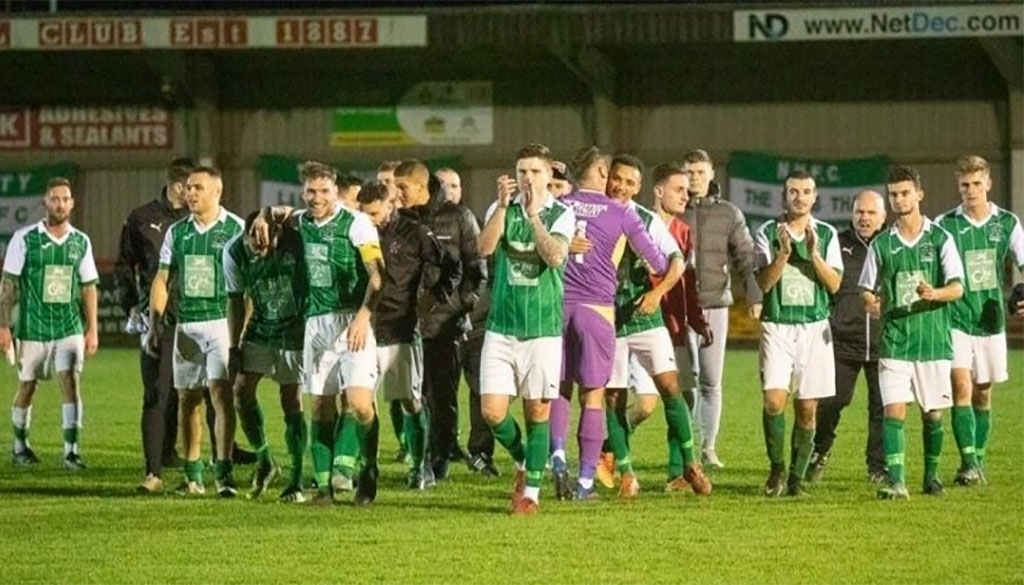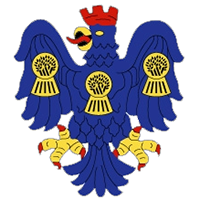
Emblematically Speaking - Northwich Victoria
Tue 10th April 2018 | Northwich Victoria | By Stewart Taylor
At first glance, the emblem of Northwich Victoria FC has a resemblance to a Roman Eagle.
There is some credibility behind the use of such an ancient heraldic device given that Northwich, known at the time as Condate, was of significance during the Roman times in England.
The reason for that was the presence of salt which was a hugely important substance in those far off times as it remains to this day.
The history of salt, whilst seeming to be somewhat mundane, is, in fact, quite fascinating and the link with many of the Cheshire towns is of great interest to historians from far and wide – well worth reading more about.
But before you do that then, we had better say that the emblem in question this week is perhaps more likely to represent a Wyvern than an Eagle – Roman or otherwise – and, as you might expect, there is a story behind that.
A Wyvern is described as a legendary creature with a dragons head and wings, reptilian body and two legs.
The normal “pose” of a Wyvern heraldically is sejant but what we see here is something of a variation on that which is unusual. The origins of Wyverns in heraldry go back to Roman times but the significance for this story is that a Wyvern appears in the crest of the Northwich Urban District Council as granted in 1962.
The presence of a Wyvern in the town crest comes from the Venables family which may be significant in the development of the football club, but that would be unlikely.
A previous article in this series introduced us to the old Kingdom of Mercia of which our old friend the River Mersey formed part of the northern border. The Wyvern has strong associations with Mercia and Northwich, being south of the River Mersey would, a good while ago, have been part of Mercia.
A further clue to the emblem being based on a Wyvern is etymological. Wyvern was once spelt “Wivre” and pronounced “Weever”. It could well be contended that this is something of a play on words, and relates to the River Weaver which joins the River Dane at Northwich.
OK, not conclusive perhaps but not too bad. The remaining devices on the emblem takes us, not for the first time, to the three wheatsheaves associated with the Earls of Chester, landowners in Northwich up to the Middle Ages, which are used in heraldic descriptions of many Cheshire towns.
The final device we can look at is the red crown on the head of the Wyvern. This relates directly to the formation and naming of the football club.
The generally accepted year for the original Northwich Victoria Football Club's founding is 1874 and the club was named in honour of the then reigning monarch, Queen Victoria – hence the crown.
The club become defunct and amalgamated with Hartford and Davenham United in February 1890 with the new club taking the old Northwich Victoria name. However, according to club historian Ken Edwards' book A Team for All Seasons, the organisation itself could have been in existence earlier in the 1870s.
The date of incorporation of the club emblem is in doubt.
The first readily accessible reference to the current emblem comes from page 338 of A Team for All Seasons which shows Kenny Jones in his football top displaying the football badge as he plants a kiss on the F.A. Trophy after a thrilling 2-1 victory in a final replay against Bangor City at Stoke City’s Victoria Ground on May 15th 1984, the first match at Wembley Stadium having ended in a 1-1 draw three days earlier.
Additional material courtesy of Di Ward which we gratefully acknowledge.
 Emblematically Speaking - Northwich Victoria
Emblematically Speaking - Northwich Victoria
Tue 10th April 2018 | Northwich Victoria
By Stewart Taylor

At first glance, the emblem of Northwich Victoria FC has a resemblance to a Roman Eagle.
There is some credibility behind the use of such an ancient heraldic device given that Northwich, known at the time as Condate, was of significance during the Roman times in England.
The reason for that was the presence of salt which was a hugely important substance in those far off times as it remains to this day.
The history of salt, whilst seeming to be somewhat mundane, is, in fact, quite fascinating and the link with many of the Cheshire towns is of great interest to historians from far and wide – well worth reading more about.
But before you do that then, we had better say that the emblem in question this week is perhaps more likely to represent a Wyvern than an Eagle – Roman or otherwise – and, as you might expect, there is a story behind that.
A Wyvern is described as a legendary creature with a dragons head and wings, reptilian body and two legs.
The normal “pose” of a Wyvern heraldically is sejant but what we see here is something of a variation on that which is unusual. The origins of Wyverns in heraldry go back to Roman times but the significance for this story is that a Wyvern appears in the crest of the Northwich Urban District Council as granted in 1962.
The presence of a Wyvern in the town crest comes from the Venables family which may be significant in the development of the football club, but that would be unlikely.
A previous article in this series introduced us to the old Kingdom of Mercia of which our old friend the River Mersey formed part of the northern border. The Wyvern has strong associations with Mercia and Northwich, being south of the River Mersey would, a good while ago, have been part of Mercia.
A further clue to the emblem being based on a Wyvern is etymological. Wyvern was once spelt “Wivre” and pronounced “Weever”. It could well be contended that this is something of a play on words, and relates to the River Weaver which joins the River Dane at Northwich.
OK, not conclusive perhaps but not too bad. The remaining devices on the emblem takes us, not for the first time, to the three wheatsheaves associated with the Earls of Chester, landowners in Northwich up to the Middle Ages, which are used in heraldic descriptions of many Cheshire towns.
The final device we can look at is the red crown on the head of the Wyvern. This relates directly to the formation and naming of the football club.
The generally accepted year for the original Northwich Victoria Football Club's founding is 1874 and the club was named in honour of the then reigning monarch, Queen Victoria – hence the crown.
The club become defunct and amalgamated with Hartford and Davenham United in February 1890 with the new club taking the old Northwich Victoria name. However, according to club historian Ken Edwards' book A Team for All Seasons, the organisation itself could have been in existence earlier in the 1870s.
The date of incorporation of the club emblem is in doubt.
The first readily accessible reference to the current emblem comes from page 338 of A Team for All Seasons which shows Kenny Jones in his football top displaying the football badge as he plants a kiss on the F.A. Trophy after a thrilling 2-1 victory in a final replay against Bangor City at Stoke City’s Victoria Ground on May 15th 1984, the first match at Wembley Stadium having ended in a 1-1 draw three days earlier.
Additional material courtesy of Di Ward which we gratefully acknowledge.


